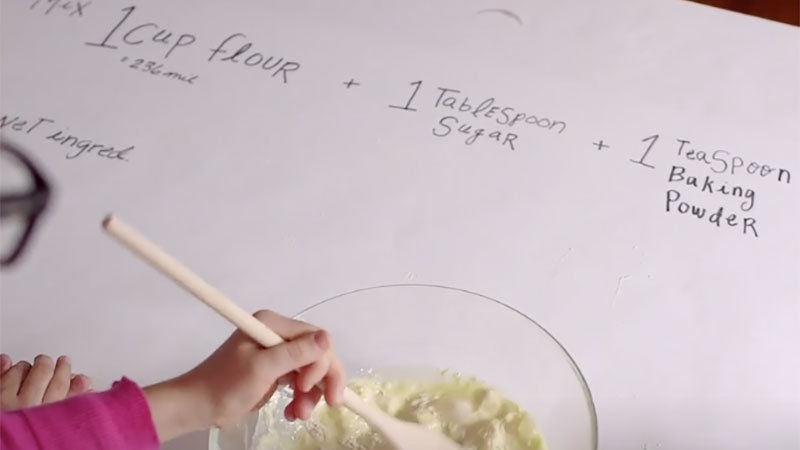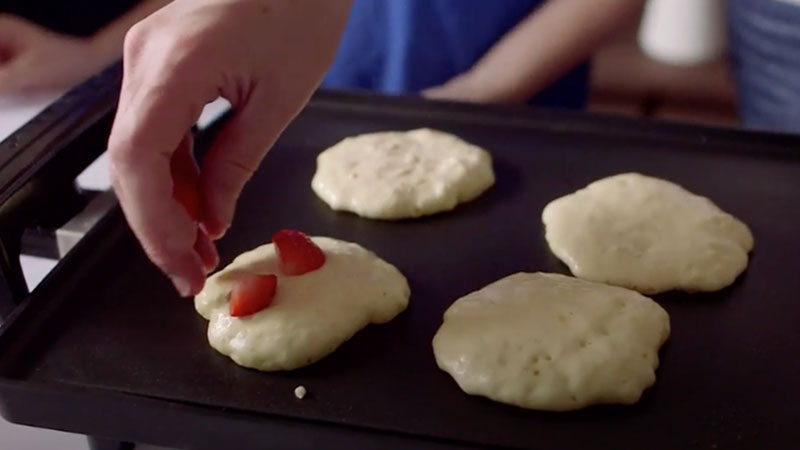Pancake Science
- Moderate
- A Little Messy
- 30 Minutes
- Outdoor
Math is delicious?
Cooking up a plate of fluffy buttermilk pancakes isn’t just a great life skill, it’s also an opportunity to work in some serious math and science lessons.
Watch the video on YouTube: https://youtu.be/x1eesom14EY
You Will Need
1 cup flour
1 teaspoon baking powder
¼ teaspoon baking soda
pinch of salt
1 cup buttermilk
1 egg
2 Tablespoons melted butter at room temperature
Hot griddle or frying pan
Directions
- Ask your child to make a few observations about the ingredients. What do they notice?
- Work in some math practice! For younger kids, have fun with fractions by laying out ½ cup or ¼ cup measuring cups and asking them how many it takes to make a whole cup. For older kids, ask them to convert the recipe from cups to milliliters for some conversion practice.
- Measure all dry ingredients, and mix them together in a large bowl.
- Measure the wet ingredients, and mix them together in a medium bowl.
- Pour the wet ingredients into the dry, and mix until just combined.
- Ask your little scientist to observe the liquid mixture. Does it look like something they are ready to eat? Have them watch from a safe place as the liquid batter transforms into a solid pancake during the next step. Ask them what they see, hear, and smell.
- Pour about a 1/4 cup of batter onto a hot, lightly-greased griddle for each pancake. Cook over medium heat until you see bubbles form on the top of the batter and the bottom of the pancake is brown. (Ask your child what they see. Do they see the bubbles? What are those bubbles doing? How did they get in there?) Flip and cook 1-2 minutes more or until the other side is brown.
- Ask your scientist to observe the pancakes now that they’ve been heated. How have they changed? Now eat your pancakes in the name of science!!
 Image from PBS Kids for Parents.
Image from PBS Kids for Parents.
 Image from PBS Kids for Parents.
Image from PBS Kids for Parents.
How it works
There are two special chemical ingredients in these pancakes: sodium bicarbonate and buttermilk.
Sodium bicarbonate is better known as baking soda. It’s a fast-acting leavening agent that fills the gluten in the flour with air. It’s also an alkaline or base.
Buttermilk is the liquid left over after churning butter. Unlike regular milk, buttermilk is slightly acidic. (Here’s another fact about buttermilk: Its sour taste comes from lactic acid. It’s the same thing that makes your muscles burn when exercising.)
When the kids combine the wet and dry ingredients, they’re really mixing an acid and base to create a chemical reaction. The result? Bubbles that form to make the pancakes light and fluffy. Have the kids observe the batter. Do they notice it expand?
Now you can talk about the chemical change that happens when the pancake batter cooks. By applying energy, in this case, heat, we’re able to change a liquid to a solid. Our liquid buttermilk mixture becomes solid pancakes we can eat.
Once the pancakes are cooked, it’s time to put all that hard work to a taste test. Plate up a stack and enjoy!
